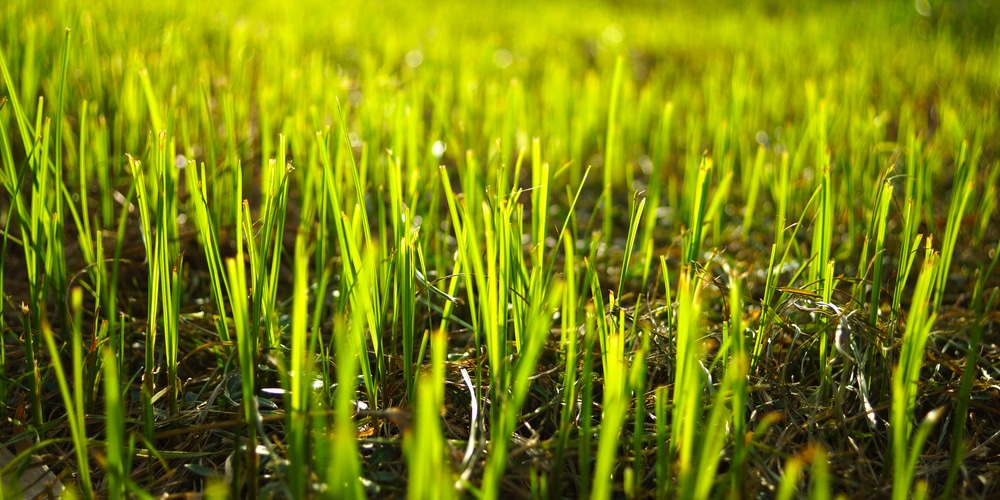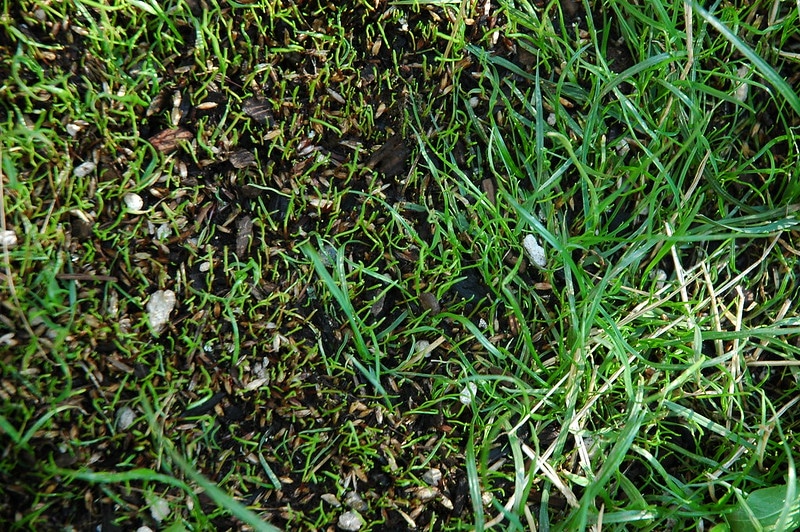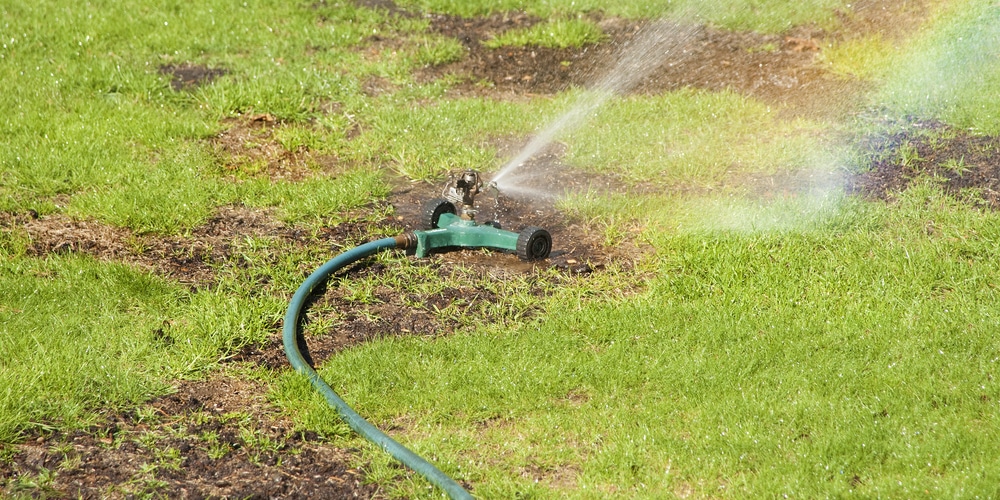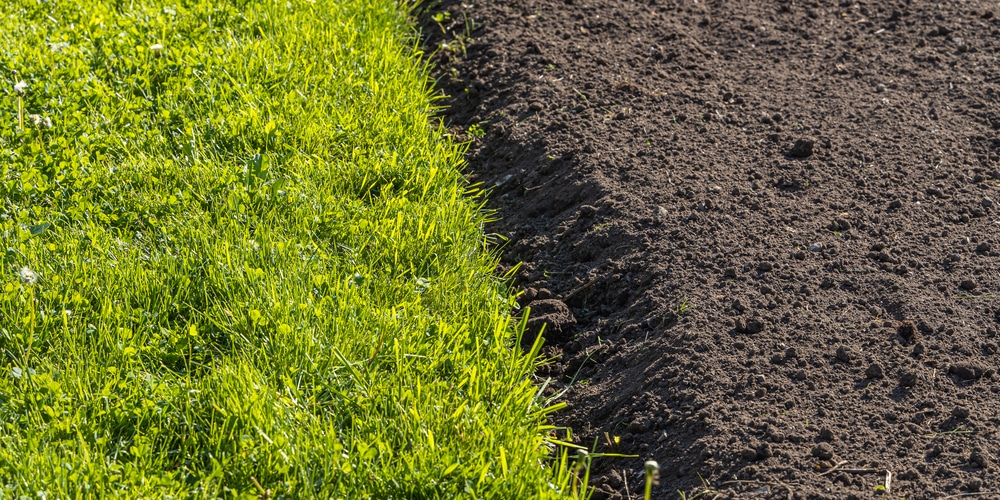How Grass Seed Germinates as it Relates to Soil
Before embarking on the journey of planting grass seed in bare spots, one must understand the types of grass seed available and the significance of soil preparation.
Proper selection and preparation are crucial steps that determine the success of a lush, healthy lawn.
Grass Seed Types
Different grass seeds thrive in varying climates and soil conditions. Common types include:
- Cool-season grasses: Ideal for northern regions with cold winters and hot summers. Examples include Kentucky Bluegrass, Perennial Ryegrass, and Fescue.
- Warm-season grasses: Best for southern areas with mild winters and very warm summers. Bermuda, Zoysia, and St. Augustine are popular varieties.
When choosing grass seed, consider the region’s climate and the lawn’s exposure to sun and shade.
Soil Analysis
Soil analysis is the first step in soil preparation. Key factors include:
- pH levels: Ideal range for most grass types is between 6.0 and 7.0.
- Nutrient levels: Essential nutrients for healthy growth are nitrogen (N), phosphorus (P), and potassium (K).
- Texture: Soil should have a balanced mix of sand, silt, and clay.
Testing kits can be purchased to determine soil pH and nutrient content, giving a clear understanding of what amendments may be needed.
Preparing the Bare Spots
To ensure successful seed germination, bare spots must be prepared by:
- Clearing debris and existing vegetation to expose the soil.
- Loosening the top 2-3 inches of soil to improve root development.
- Adding amendments like compost or topsoil if needed to enrich poor soil.
- Leveling the area to avoid water pooling and ensure even seed distribution.
Once these steps are completed, the soil will be optimal for planting grass seed and fostering strong growth.
Sowing Grass Seed
Sowing grass seed accurately and timely ensures that bare spots in a lawn fill in with healthy, new grass. Proper techniques and understanding the best timing for planting are crucial for achieving optimal seed-to-soil contact, essential for seed germination.
Seeding Techniques
When sowing grass seed, a gardener should distribute the seeds evenly over the prepared bare spots, targeting several seeds per square inch.
They should lightly rake the seeds into the top layer of the soil or compost, or use a roller to gently press the seeds into the soil. This promotes good seed-to-soil contact without burying the seeds too deeply, which can impede germination.
Timing for Planting
The best time for planting grass seed in bare spots is during periods of mild temperatures and ample rainfall, typically in the spring or autumn.
Optimal germination occurs when soil temperatures are between 8-10°C (46-50°F). Planting during these seasons also reduces the likelihood of seedlings’ exposure to the extreme heat and cold that can damage their development.
Seed-to-Soil Contact
Good seed-to-soil contact is vital for the germination of grass seeds. They need to be in direct contact with moist soil.
To increase this contact, once seeds are sown:
- Rake lightly to mix the seeds with the topsoil.
- Apply a thin layer of finely sieved compost or soil over the seeds.
- Water the area gently but thoroughly to saturate the soil without washing away the seeds.
Using these methods, the gardener creates the ideal environment for grass seeds to absorb moisture, trigger germination, and establish roots effectively.
Post-Planting Care
Once grass seeds are sown, post-planting care becomes essential to ensure the healthy growth of new grass.
Proper watering, fertilizing, and weed prevention are cornerstone practices that must not be overlooked for successful germination and establishment of the lawn.
Watering Requirements
Frequency: Initially, the seeded area should be watered lightly but consistently, aiming for at least once a day to keep the soil moist.
During the germination period, the top inch of soil should not be allowed to dry out.
Amount:
- Weeks 1-2: Daily watering or multiple times a day if needed, with about a quarter-inch of water.
- Weeks 3-4: Reduce frequency to every other day, increasing the amount of water (about a half-inch) to encourage deeper root growth.
Fertilizing Schedule
Initial Application: Apply a starter fertilizer at the time of seeding to supply essential nutrients. Look for products that are high in phosphorus to aid root development.
| Week Since Planting | Fertilizer Action |
|---|---|
| Week 4-6 | Apply half the amount of the starter fertilizer to support the young grass. |
| Every 6-8 weeks thereafter | Transition to a regular lawn fertilizer, balanced in nitrogen, phosphorus, and potassium. |
Weed Prevention
Pre-emergent Herbicides: These should not be used during the seeding process as they can inhibit grass seed germination.
Wait until the new grass has been mowed at least 3 times before considering a pre-emergent weed control.
Manual Removal: The best practice for early weed control is manual removal.
Inspect the lawn regularly and carefully remove any weeds, ensuring to get the roots, so they don’t compete with the new grass for nutrients and water.
Common Mistakes to Avoid
In the endeavor to cultivate a lush lawn, gardeners may inadvertently commit errors that can impede the growth of new grass. Being aware of these pitfalls is crucial to ensure the successful germination and establishment of grass seed.
Ignoring Soil pH
The acidity or alkalinity of soil, denoted by its pH level, directly affects grass seed germination. Most grass types flourish in a slightly acidic to neutral pH range of 6.5 to 7.
Neglecting to test and adjust soil pH prior to seeding can lead to poor seedling development.
Overwatering
While consistent moisture is vital for seed germination, excessive watering can be detrimental.
Overwatering can lead to:
- Seed rot
- Fungal growth
It’s important to maintain a balance, ensuring the soil stays damp but not saturated.
Neglecting Seed Coverage
Proper seed-soil contact is essential for the growth of grass. Seeds left exposed without sufficient coverage are vulnerable to:
- Birds and insects
- Wind or runoff
Seeds should be lightly raked into the soil and, if needed, protected with a thin layer of straw to maintain moisture and provide coverage.
Long-Term Maintenance
Once a lawn owner sees their bare spots beautifully transformed into lush, green grass, maintaining that verdant look is essential. The health and appearance of the lawn over time hinge on proper long-term care, including mowing, aeration, overseeding, and seasonal adjustments.
Mowing Guidelines
Grass should be mowed at the correct height, which varies by grass type but typically ranges between 2 to 3 inches.
It’s crucial to use sharp mower blades to avoid tearing the grass, which can lead to disease and damage.
A good practice is to mow often enough that no more than one-third of the grass blade is removed at a time.
Aeration and Overseeding
Lawns benefit from aeration at least once a year, which involves creating small holes in the soil to allow air, water, and nutrients to penetrate the grass roots.
This helps the roots grow deeply and produce a stronger, more vigorous lawn.
Overseeding, which is the process of planting new grass seed to fill in thinning areas, should be done concurrently with aeration to ensure optimal seed-to-soil contact.
Seasonal Lawn Care
Lawn care routines change with the seasons. For instance:
- Spring: Fertilize and apply pre-emergent herbicides to prevent weed growth.
- Summer: Increase watering frequency to combat heat stress, but do it early in the morning to reduce evaporation.
- Fall: This is an ideal time for aeration, overseeding, and applying potassium-rich fertilizer to prepare the grass for winter.
- Winter: Keep the lawn clear of debris and reduce foot traffic to prevent damage to the dormant grass.
Frequently Asked Questions
In tending to a lawn, homeowners often grapple with the repair of unsightly bare patches.
Addressing this, the following subsections aim to clarify common uncertainties regarding the rejuvenation of these areas using grass seed.
What is the most effective method for repairing bare patches in a lawn?
The most effective method involves loosening the soil, enriching it with compost, spreading a suitable grass seed evenly, and then gently raking the seeds into the topsoil.
Regular watering without causing waterlogging is crucial for the seeds to thrive.
When should one overseed bare spots for optimal growth?
The ideal time for overseeding bare spots is during the growing seasons of spring or autumn.
These are when the soil temperature is conducive to germination—typically between 8-10 °C.
How does one ensure successful grass seed germination on bare spots?
The key to successful germination is maintaining consistent soil moisture while avoiding water saturation.
Providing proper soil contact by lightly raking the seeds in and ensuring the bare spots receive adequate sunlight also greatly aids in germination.
What quantity of grass seed is required for covering bare spots adequately?
The amount of grass seed needed is determined by the specific product’s coverage rating, often conveyed as overseeding and new-lawn figures.
Generally, several seeds per square inch should suffice to establish a full appearance.
What are the steps to overseed dead spots in a lawn to ensure growth?
One should first assess the cause of the dead spots, select the appropriate seed type, loosen the topsoil, add a nutrient-rich layer of compost, distribute the grass seeds evenly, rake them gently for soil contact, and ensure frequent light watering during germination.
Is it possible for bare spots to recover on their own, or is overseeding necessary?
Bare spots generally do not recover on their own. Overseeding is necessary to restore lushness.
Good preparation, the right grass selection, and proper maintenance can effectively turn bare patches green.
Last update on 2025-06-06 / Affiliate links / Images from Amazon Product Advertising API






